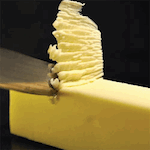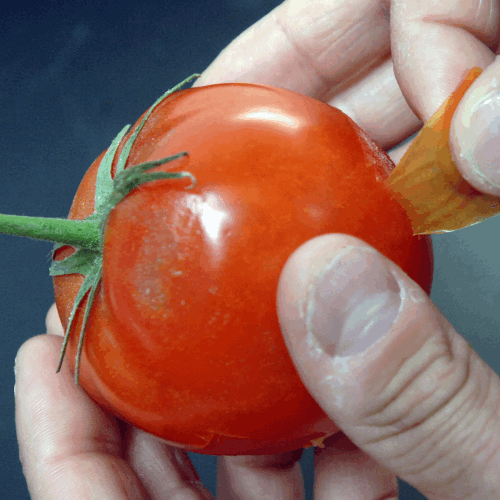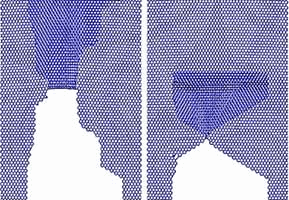In past studies, in collaboration with Benoit Roman, we have addressed the extremely robust patterns that emerge in the fracture of thin brittle sheets both in the context of cutting by a blunt object and tearing. We have shown that this robustness of the obtained fracture patterns results from the prominent role of geometry in the processes. For example, we have analyzed the triangular shapes formed when tearing a thin adhesive sheet from a solid substrate. An everyday example of this process is the annoying triangular piece that one ends up with when unsuccessfully trying to peel tape from a roll of scotch-tape. In collaboration with Markus Buehler (MIT) and Kostya Novoselov (Manchester), we have demonstrated that similar fracture patterns can also be found when tearing graphene sheets.
|
Fracture Toughness through Scratching with: Ange-Therese Akono and Franz Ulm |
|
|

|
We present results of a hybrid experimental and theoretical investigation of the fracture scaling in scratch tests and show that scratching is a fracture dominated process. Validated for paraffin wax, cement paste, Jurassic limestone and steel, we derive a model that provides a quantitative means to relate quantities measured in scratch tests to fracture properties of materials at multiple scales. The scalability of scratching for different probes and depths opens new venues towards miniaturization of our technique, to extract fracture properties of materials at even smaller length scales. Video of the scratching experiments on paraffin: [Movie] Publications: Press Coverage: |
|
Tearing of thin adhesive sheets with: Benoit Roman, Enrique Cerda, and Eugenio Hamm |
|
|

|
Thin adhesive films have become increasingly important in applications involving packaging, coating or for advertising. Once a film is adhered to a substrate, flaps can be detached by tearing and peeling, but they narrow and collapse in pointy shapes. Similar geometries are observed when peeling ultrathin films grown or deposited on a solid substrate, or skinning the natural protective cover of a ripe fruit. In this work, we have shown that the detached flaps have perfect triangular shapes with a well-defined vertex angle; this is a signature of the conversion of bending energy into surface energy of fracture and adhesion.In particular, this triangular shape of the tear encodes the mechanical parameters related to these three forms of energy and could form the basis of a quantitative assay for the mechanical characterization of thin adhesive films, nanofilms deposited on substrates or fruit skin. Publications: Press Coverage: |
|
Tearing of Graphene Sheets with: Dipanjan Sen, Kostya Novoselov and Markus Buehler |
|
|

|
Graphene is a truly two-dimensional atomic crystal with exceptional electronic and mechanical properties. Whereas conventional bulk and thin-film materials have been studied extensively, the key mechanical properties of graphene, such as tearing and cracking, remain unknown, partly due to its two-dimensional nature and ultimate single-atom-layer thickness, which result in the breakdown of conventional material models. By combining first-principles ReaxFF molecular dynamics and experimental studies, a bottom-up investigation of the tearing of graphene sheets from adhesive substrates is reported, including the discovery of the formation of tapered graphene nanoribbons. Through a careful analysis of the underlying molecular rupture mechanisms, it is shown that the resulting nanoribbon geometry is controlled by both the graphene-substrate adhesion energy and by the number of torn graphene layers. By considering graphene as a model material for a broader class of two-dimensional atomic crystals, these results provide fundamental insights into the tearing and cracking mechanisms of highly confined nanomaterials. Publications: Press Coverage: |
|
Oscillatory Fracture in Thin Sheets with: Benoit Roman, Basile Audoly, Anil Kumar, Mark Shattuck and Simon de Villiers |
|
|

|
Opening the plastic packaging film of biscuit packs or CD cases has never been easy, specially if one lacks a pen-knife in our pocket. One way out is to use a key or a pen. If we use such a blunter object to tear open the plastic, rather than observing a straight cut, the crack follows a well defined and highly reproducible oscillatory path. We have developed a well controlled experiment in which to study this phenomena. Moreover, we have developed a geometrical 2D model that takes into account bending and stretching of the thing plastic film. This simplemodel yields results in excellent agreement with the experiments. Publications: Press Coverage: |